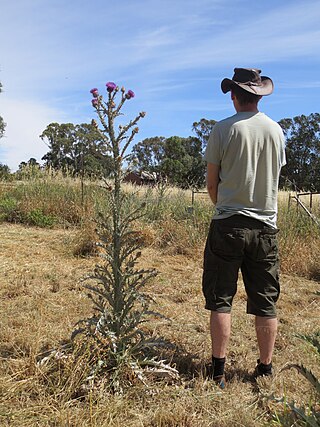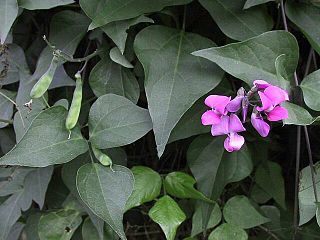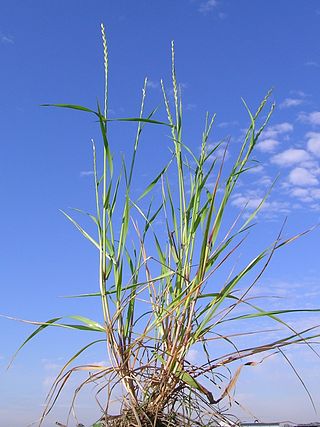
Cuscuta, commonly known as dodder or amarbel, is a genus of over 201 species of yellow, orange, or red parasitic plants. Formerly treated as the only genus in the family Cuscutaceae, it now is accepted as belonging in the morning glory family, Convolvulaceae, on the basis of the work of the Angiosperm Phylogeny Group. The genus is found throughout the temperate and tropical regions of the world, with the greatest species diversity in subtropical and tropical regions; the genus becomes rare in cool temperate climates, with only four species native to northern Europe.

Weed control is a type of pest control, which attempts to stop or reduce growth of weeds, especially noxious weeds, with the aim of reducing their competition with desired flora and fauna including domesticated plants and livestock, and in natural settings preventing non native species competing with native species.

Bromus tectorum, known as downy brome, drooping brome or cheatgrass, is a winter annual grass native to Europe, southwestern Asia, and northern Africa, but has become invasive in many other areas. It now is present in most of Europe, southern Russia, Japan, South Africa, Australia, New Zealand, Iceland, Greenland, North America and western Central Asia. In the eastern US B. tectorum is common along roadsides and as a crop weed, but usually does not dominate an ecosystem. It has become a dominant species in the Intermountain West and parts of Canada, and displays especially invasive behavior in the sagebrush steppe ecosystems where it has been listed as noxious weed. B. tectorum often enters the site in an area that has been disturbed, and then quickly expands into the surrounding area through its rapid growth and prolific seed production.

Onopordum acanthium is a flowering plant in the family Asteraceae. It is native to Europe and Western Asia from the Iberian Peninsula east to Kazakhstan, and north to central Scandinavia, and widely naturalised elsewhere, with especially large populations present in the United States and Australia. It is a vigorous biennial plant with coarse, spiny leaves and conspicuous spiny-winged stems.

Centaurea diffusa, also known as diffuse knapweed, white knapweed or tumble knapweed, is a member of the genus Centaurea in the family Asteraceae. This species is common throughout western North America but is not actually native to the North American continent, but to the eastern Mediterranean.

Polygonum arenastrum, commonly known as equal-leaved knotgrass, is a summer annual flowering plant in the knotweed family Polygonaceae. Other common names include common knotweed, prostrate knotweed, mat grass, oval-leaf knotweed, stone grass, wiregrass, and door weed, as well as many others. It is native to Europe and can be found on other continents as an introduced species and a common noxious weed. Knotweed was first seen in North America in 1809 and is now seen across much of the United States and Canada.

Centaurea solstitialis, the yellow star-thistle, is a species of thorny plant in the genus Centaurea, which is part of the family Asteraceae. A winter annual, it is native to the Mediterranean Basin region and invasive in many other places. It is also known as golden starthistle, yellow cockspur and St. Barnaby's thistle.

Acacia saligna, commonly known by various names including coojong, golden wreath wattle, orange wattle, blue-leafed wattle, Western Australian golden wattle, and, in Africa, Port Jackson willow, is a small tree in the family Fabaceae. Native to Australia, it is widely distributed throughout the south west corner of Western Australia, extending north as far as the Murchison River, and east to Israelite Bay. The Noongar peoples know the tree as Cujong.

Osteospermum moniliferum is an evergreen flowering shrub or small tree in the daisy family, Asteraceae. It is native to southern Africa, ranging through South Africa and Lesotho to Mozambique and Zimbabwe.

Melilotus albus, known as honey clover, white melilot (UK), Bokhara clover (Australia), white sweetclover (US), and sweet clover, is a nitrogen-fixing legume in the family Fabaceae. Melilotus albus is considered a valuable honey plant and source of nectar and is often grown for forage. Its characteristic sweet odor, intensified by drying, is derived from coumarin.

A noxious weed, harmful weed or injurious weed is a weed that has been designated by an agricultural or other governing authority as a plant that is injurious to agricultural or horticultural crops, natural habitats or ecosystems, or humans or livestock. Most noxious weeds have been introduced into an ecosystem by ignorance, mismanagement, or accident. Some noxious weeds are native. Typically they are plants that grow aggressively, multiply quickly without natural controls, and display adverse effects through contact or ingestion. Noxious weeds are a large problem in many parts of the world, greatly affecting areas of agriculture, forest management, nature reserves, parks and other open space.

Lathyrus aphaca, known as the yellow pea or yellow vetchling, is an annual species in the family Fabaceae with yellow flowers and solitary, pea-like fruits. It originated in the Middle East and has spread throughout Europe and beyond as a weed of cultivated fields and roadsides. The fruits are eaten as a supplement to diets in some parts of South Asia but are narcotic and potentially toxic in large quantities.

Lantana camara is a species of flowering plant within the verbena family (Verbenaceae), native to the American tropics. It is a very adaptable species, which can inhabit a wide variety of ecosystems; once it has been introduced into a habitat it spreads rapidly; between 45ºN and 45ºS and more than 1,400 metres in altitude.

A weed is a plant considered undesirable in a particular situation, growing where it conflicts with human preferences, needs, or goals. Plants with characteristics that make them hazardous, aesthetically unappealing, difficult to control in managed environments, or otherwise unwanted in farm land, orchards, gardens, lawns, parks, recreational spaces, residential and industrial areas, may all be considered weeds. The concept of weeds is particularly significant in agriculture, where the presence of weeds in fields used to grow crops may cause major losses in yields. Invasive species, plants introduced to an environment where their presence negatively impacts the overall functioning and biodiversity of the ecosystem, may also sometimes be considered weeds.

Torilis japonica, the erect hedgeparsley, upright hedge-parsley or Japanese hedge parsley, is a herbaceous flowering plant species in the celery family Apiaceae. Japanese hedge parsley is considered both an annual and biennial plant depending on the biogeographical location. This means Japanese hedge parsley can complete its life cycle in either one or two growing seasons depending on habitat. Japanese hedge parsley is typically found in areas with disturbed soils, pastures, margins, open woodland, near waste sites, or right-of-way habitats. It can withstand a variety of habitats, thriving in partial and full shaded areas, but also withstanding habitats with full sunlight penetration. It is considered an aggressive invasive species in North America; invading a wide range of habitats due to its environmental tolerance and tendency to outcompete native vegetation. This species is considered a threat in several areas that causes problems relating to overall environmental health and stability. Aside from its environmental implications, T. japonica has potential to fight several cancers through a terpene it produces called Torilin, extracted from its fruits.

Linaria dalmatica is a herbaceous, short-lived perennial plant native to western Asia and southeastern Europe that has become a weed in other areas. The family this plant now belongs to is the Plantaginaceae Family. Previously, it belonged to the Scrophulariaceae (Figwort) family. Its common names include Balkan toadflax, broadleaf toadflax, and Dalmatian toadflax. Linaria dalmatica has unique yellow flowers with an orange center that draw individuals to purchase them to display in their gardens. The distribution of L. dalmatica to North America can be attributed to use as a fabric dye, folk remedies and as an ornamental plant. However, it is now classified as a weed in both Canada and the U.S.A.

Dipogon lignosus, the okie bean, Cape sweet-pea, dolichos pea or mile-a-minute vine, is a species of flowering plant in the legume family, Fabaceae. It is the only species classified in the monotypic genus Dipogon which belongs to the subfamily Faboideae.

Arctotheca populifolia is a species of flowering plant in the family Asteraceae known by the common names beach daisy, Cape beach daisy, South African beach daisy, coast capeweed, dune arctotheca, beach pumpkin, sea pumpkin, dune cabbage, and in South Africa, seepampoen, tonteldoek, and strandgousblom. This species is native to coastal areas of the Cape Provinces and KwaZulu-Natal in South Africa, and of Mozambique. It was introduced to Australia and is now a common weed of coastal areas in New South Wales, South Australia, Tasmania, Victoria, and Western Australia.

Lolium rigidum is a species of annual grass. Common names by which it is known include annual ryegrass, a name also given to Italian ryegrass, rigid ryegrass, stiff darnel, Swiss ryegrass and Wimmera ryegrass. It is a native of southern Europe, northern Africa, the Middle East and the Indian subcontinent and is grown as a forage crop, particularly in Australia, where it is also a serious and economically damaging crop weed.

Oncosiphon pilulifer, also known as globe chamomile and stinknet, is a flowering plant in the daisy family (Asteraceae) native to South Africa and Lesotho. It is considered invasive in some parts of North America.





















